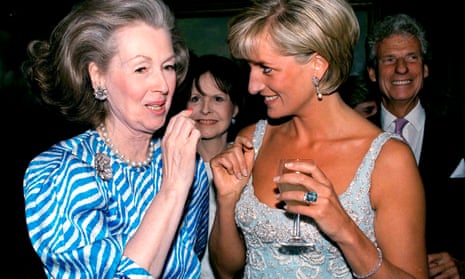Raine, Countess Spencer, who has died aged 87, was an irrepressible force. Beneath an overt charm she could be ruthless, and, transfixing anyone who dared to challenge whatever cause she was pursuing with an electric-light smile, would sweep all opposition aside. Her critics said she tended to go straight for the jugular. She certainly knew how to get the show on the road, and Prince Philip is reputed to have remarked: “If you want to get anything organised, send for Raine.”
Two aspects of her colourful family life were of more than usual interest to the wider world: that she was the daughter of Barbara Cartland, the author of more than 600 romantic novels, and stepmother of Diana, Princess of Wales. But she was determined to do more than be a society figure.
From her marriage in 1948 to Gerald Legge, later Lord Lewisham and then Earl of Darmouth, she had three sons and a daughter. When she was elected to Westminister city council for the Conservatives in 1954, she was its youngest member. In 1958 she was elected to the Lewisham West seat on the old London County Council, and retained her dual representation until 1965.
That year the LCC was superseded by the Greater London council, and in 1967 the then Lady Dartmouth was elected to it to represent Richmond. During her six years on the GLC, her particular interests lay in town planning, historic buildings and the environment, and she was chair of the Covent Garden development committee (1971-72). She then became very involved with the British Tourist Authority.
In 1996, Mohamed al Fayed, owner of Harrods, appointed her a director of Harrods International. She took the job seriously, and frequently put on a packer’s apron to work a seven-hour night shift at the distribution plant in Osterley, west London, occasionally hitching a lift home in a warehouseman’s car.
However, she did not obtain the seat in the Commons that might have been expected. An objective friend who watched her progress said: “She never took any prisoners, and never took no for an answer. She would have made a first-rate chairman of the rail network, and, like Mussolini, would have made the trains run on time.”
In 1976, she and Lord Dartmouth divorced. Later that year, she married Earl Spencer, the father of Princess Diana from his first marriage, and a close friend of Raine’s first husband. Diana’s mother remarried to become Frances Shand Kydd.
Fashionable opinion was that Raine had “traded up” and had married not the man, but Althorp, the Spencer family seat in Northamptonshire. There was an element of truth in the jibe, because she regarded the man and the estate as inseparable, and was devoted to both. Installed as chatelaine, she started a restoration of both the house and the estate finances. The cost was high, causing a rift between her and her four stepchildren, who dubbed her “Acid Raine”.
They accused both her and her father of selling off family treasures and estate cottages to pay for the redecoration of Althorp, and “Raine, Raine, go away!” became the family mantra. Viscount Althorp, the present Earl Spencer, said the decor resembled “the wedding cake vulgarity of a five-star hotel in Monaco”.
Raine, unabashed by the criticisms, said: “I thought I made a wonderful job of Althorp. There were bright sofas to sit on, and you could still look at the Rubens on the walls and think how lucky you were to be living there.”
There were, however, the strongest bonds of affection between Raine and her second husband, and even her detractors admired the way she nursed him back to health after a near-fatal stroke two years into their marriage. When he died of a heart attack in March 1992, she left Althorp and moved back to her house in Farm Street, Mayfair, refusing to discuss the stormy relationship with her stepchildren.
She was, however, gratified when she achieved a reconciliation with Diana, who invited her to dinner at her Kensington Palace apartment and told her: “Thank you for looking after Daddy. I know you loved him.”
Born in London, Raine was at first educated alone by governesses, and at the start of the second world war was sent to Canada as an evacuee, albeit a privileged one. Her father, Alexander McCorquodale, of Cound Hall, Cressage, Shropshire, was divorced by her mother, Barbara (nee Cartland), in favour of his first cousin when Raine was only four, and seems to have played no lasting role in his daughter’s life.
Her stepfather, Hugh, was equally distant, and the two sons of the second marriage were too far apart from her in age to provide true sibling affection. She was raised to be a debutante, and in 1947 was presented at court, being nominated Deb of the Year.
Legge took the courtesy title of Viscount Lewisham when his father succeeded to the earldom of Darmouth in 1958, and himself succeeded as 9th earl four years later. But of all her titles, Raine said that Lewisham was her favourite, because “it’s on the buses”.
Her third marriage came in 1993, to the rather younger and allegedly financially challenged Comte Jean-François de Chambrun. Raine showed no sign of distress when three years later they amicably divorced.
In the evidence she gave to the inquest in 2007 into Diana’s death 10 years previously, Raine spoke of the understanding that they came to share: “She always said I had no hidden agenda. So many people, because she was so popular and so world famous, wanted something out of her. It was a very draining life.”
After she had ceased to be a comtesse, she reverted to the Spencer name. She is survived by her chidren.

Comments (…)
Sign in or create your Guardian account to join the discussion